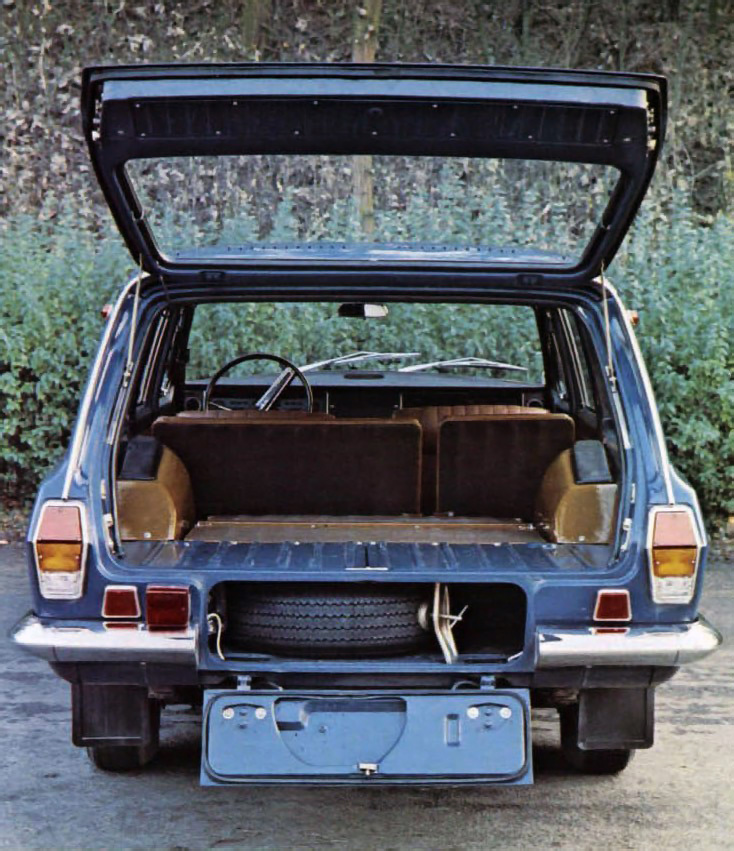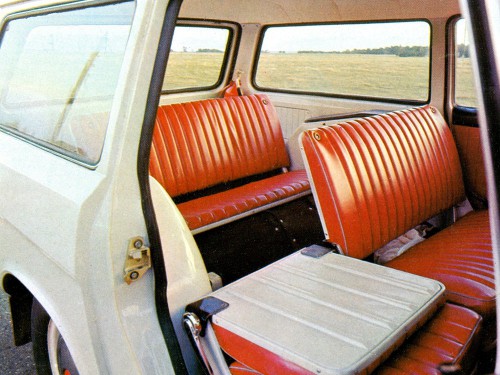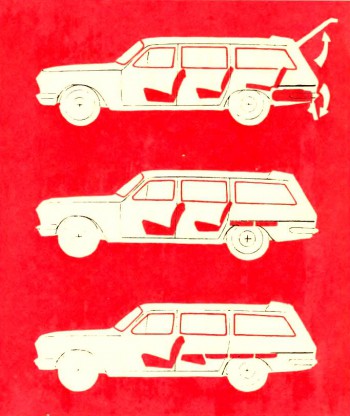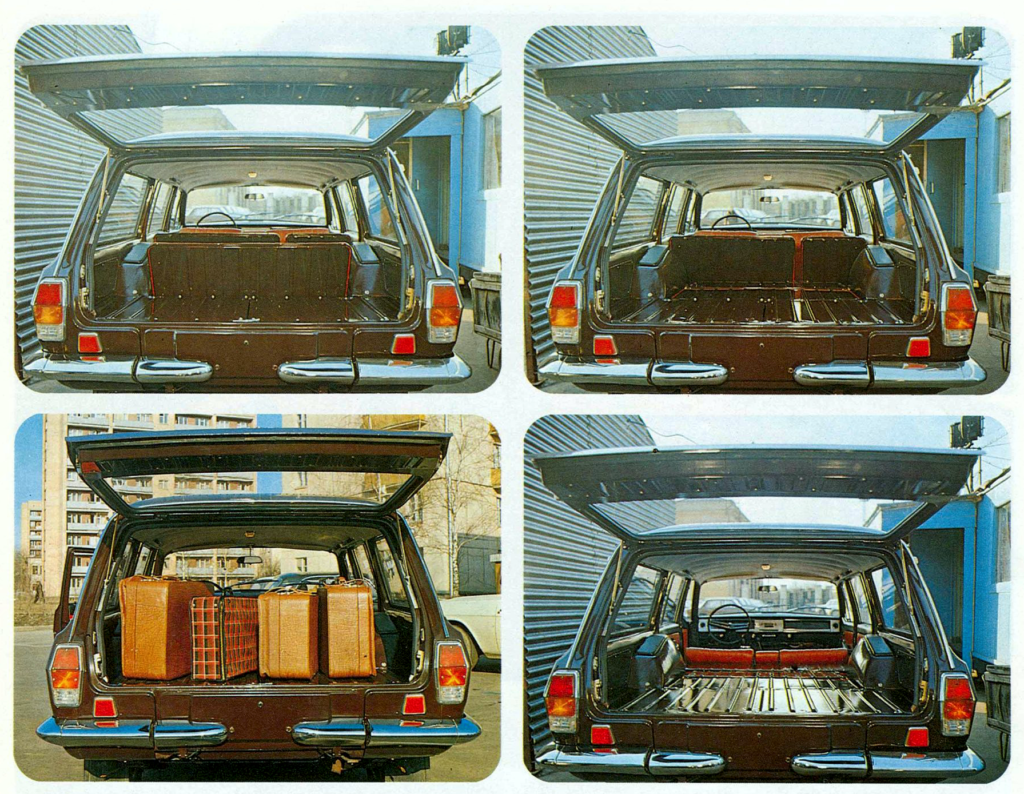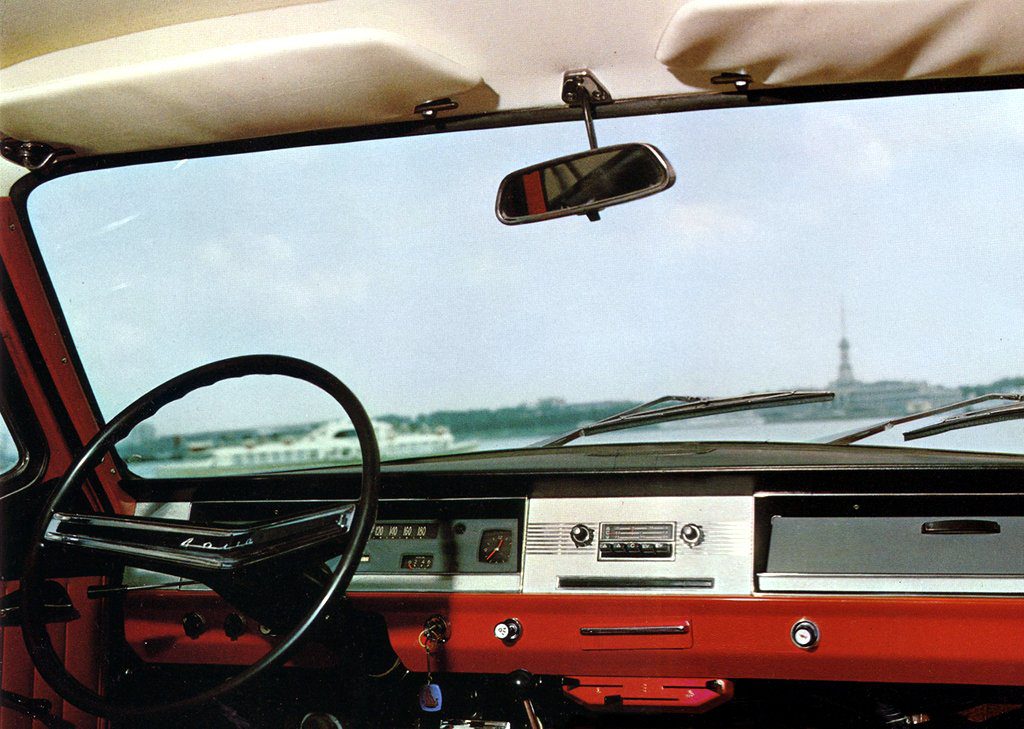
The Volga’s interior is not very spacious by today standards; it is wide, but relatively short, the leg room is not all that great and overall interior volume is roughly equivalent to much smaller modern cars, like Toyota Corolla or Chevrolet Cruze – space utilization standards were vastly different back in 1960s when the car was designed. Seating position is also relatively low by modern standards, although not as low as in some European cars from the same time frame.
However, it is still roomy enough for five normal sized adults to sit relatively comfortably. And, being not cluttered with such space-robbing design elements as a center console or thick door trim panels, it offers more actual space than you may expect for it’s volume.
Early cars with a front bench seat were sometimes designated as six-seaters, but the third seat up front is essentially nothing more than a joke.
The trim is lowly, but practical and quite durable, in accordance with the car’s primary purpose as a taxicab. Thin roof pillars and a large glass area provide good visibility in general, despite the thick C-pillars obstructing over-left-shoulder visibility somewhat. All four corners of the car are visible from the driver’s seat, which is quite unusual for a driver used to the rounded modern cars.
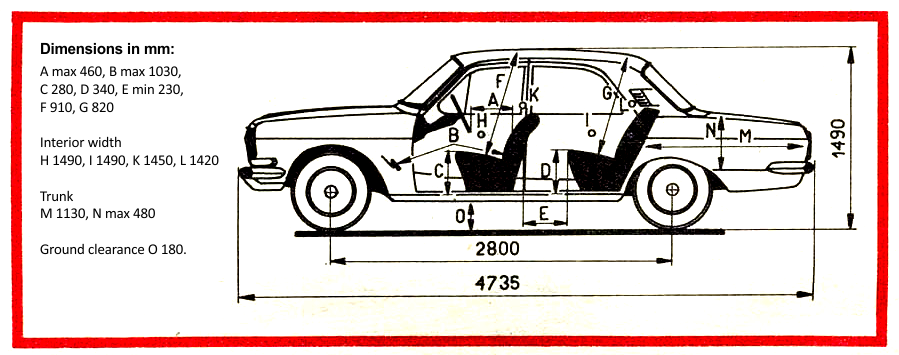
Driver’s seating position is only good for people who are shorter than ~180 cm / 6 feet, and a taller driver will most likely find it somewhat cramped. The huge (430 mm) steering wheel is especially offensive and tends to rub against the tall driver’s thighs. Naturally, the steering column is not adjustable in any direction.
The simple, minimalist dashboard featured symmetrical layout with all switchgear in one continuous horizontal strip at the bottom. The instrument cluster and glove box door could be easily swapped from one side to the other to produce left or right hand drive vehicles for different markets. Circular air vents helped to keep the front door glass from fogging up, and there was also a rear window defogger. Radio was standard equipment, except for the taxicabs, which were equipped with a taximeter instead.
When the Volga was introduced in late 1960s, the dashboard was painted metal, with it’s flat top covered by black vinyl to prevent reflections in the windshield, and featured matte chrome trim, which was later gradually replaced by simulated wood grain. Switches were of the “pull-push-turn” type, with small round plastic knobs – black with ivory inserts.
In the fall of 1977 this design gave way to a more modern plastic-covered dashboard, still with stamped metal frame under the soft padding. Several months before the transition, the knobs had been replaced by larger ones, with rounded edges for added safety and larger, better visible pictogram.
The instrument cluster incorporated five gauges – speedometer, ammeter, oil pressure, temperature and gas, as well as an electric clock and four warning lights – for turning signals, parking brake, low oil pressure and engine overheating. At some point, additional warning light for the brakes was added.
Ribbon type speedometer had been used initially, but early in 1975 it was replaced by a conventional square gauge with a needle pointer, which, while not as stylish, proved to be more durable as well as easier to read.
Ventilation and heater/defroster controls were grouped on a small separate panel located under the dashboard in the middle. There were three slide levers (not clearly labeled) which controlled air baffles via cables. By pushing and pulling the lower-most lever, the heater could be set to heat the interior through air ducts behind the dashboard, to defrost the windshield and front door glass or to do both task at a time. The right-most lever controlled the flow of fresh outside air into the heater, which was mixed with hot air from the heater core to regulate the temperature, and the left-most one opened or closed the cold air ventilation hatch located in the cowl area. The blower switch was located separately from the other controls at the left side of the dashboard, between the windshield washer and manual choke knobs.
Door trim panels were two-tone, with black upper sections and lower ones color-keyed to the interior. The upper sections which formed the top contour of the panels originally had been vinyl-covered metal stampings with soft foam rubber padding, and about 1976 they were substituted with plastic-covered parts.
Lower sections differed on early and late production cars, too: being graced by simple vertical pleats until mid-1976, they received a more complicated horizontal pattern later. The reason behind this change is not known, but it roughly coincided with the transition to the late style of seats circa 1977.
Door panel bottoms were protected from tear and wear by corrugated aluminum kick plates – as well as the door sills. Front doors had map pockets, albeit very small and suitable only to hold road maps or a slim book, like the Owner’s Manual.
Seats were built in the old-fashioned way, with coil and band springs mounted on metal upholstery frames, just like in an interior couch.

Early cars featured a split bench seat up front, with a folding arm rest. The cushion was split into three separate sections; both side sections were individually adjustable, and the center section, which took up about 15% of the overall width, could be used either as a jump seat for an occasional passenger, or, if the soft insert was removed, as a rudimentary center console (kind of reminiscent of the 3rd generation Ford Taurus’ front seat with its “flip-fold” center console, but simpler in design).
Backrest inclination could be adjusted with a simple pull of a lever (on the previous model it required unscrewing two bolts, which were located on the opposite sides of the bench seat). By folding the front seat backs and the center armrest all the way down, a somewhat uneven, but still decent sleeping surface for the night could be arranged, which was a nice touch because motels were pretty scarce back then, and sleeping in a car close to the road was mostly safe.
On prototypes and the very earliest production cars seat facings were completely covered in cloth (cotton warp / wool weft), its pattern reminiscent of the cloth used in late production GAZ-21 Volga, with the rest of the seat in vinyl artificial leather. Very early on in the production run, this pattern of upholstery was superseded by another one, with vinyl side bolsters and a cheaper, plainer-looking, but more durable semi-synthetic cloth. The seat innards were cheapened out somewhat as well.
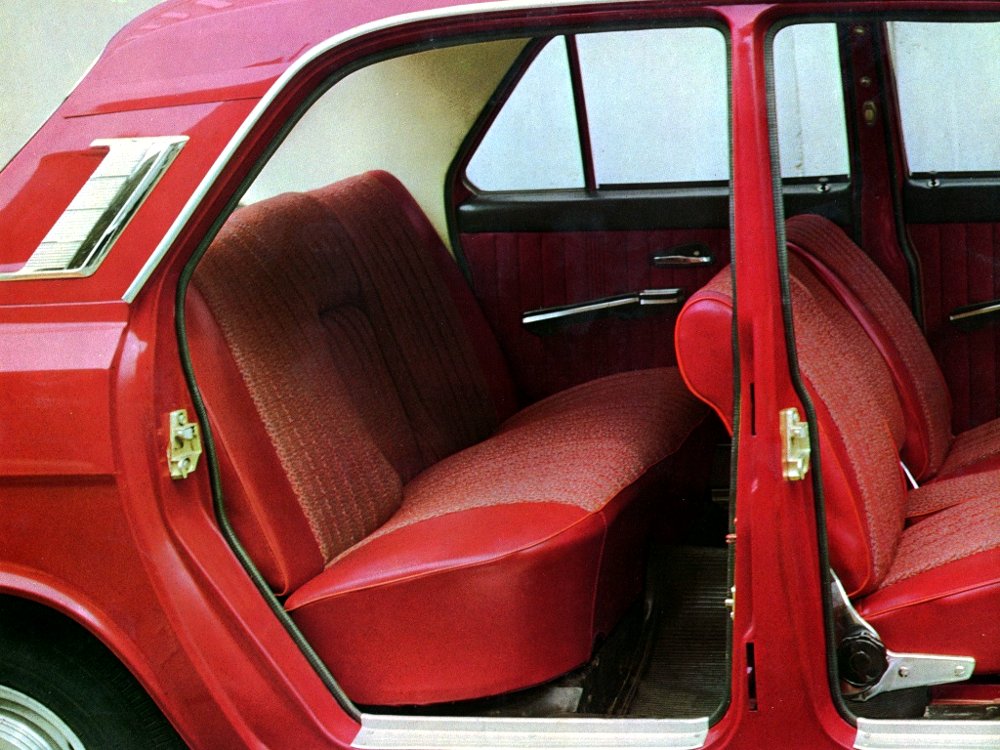
Backseat was designed for three-across seating and also equipped with a folding center armrest.
Overall, the seats are relatively comfortable as old car seats go, but offer absolutely no lateral support and feel “bouncy” because of their spring-loaded construction. On most cars they are very worn out, even if the upholstery is still holding up and looking good – the springs are either sagged or broken and the soft padding has literally disintegrated into dust.
Early in 1977 the armrest and the center section of the cushion between driver’s and passenger’s seats were eliminated, thus forming two completely separate front seats – still with completely flat cushions and no lateral support to speak of. The style of upholstery was changed, too, and vinyl side bolsters were removed (apparently because the new cloth was durable enough). However, the seat frames remained unchanged.
Taxicabs, as well as many station wagons, had all-vinyl upholstery, which was durable, easy to wash and didn’t become soaked with water. The driver’s seat, however, retained vinyl-and-cloth upholstery, as it was found that sitting all day on a piece of artificial leather is not exactly the best thing for the driver’s comfort and health.
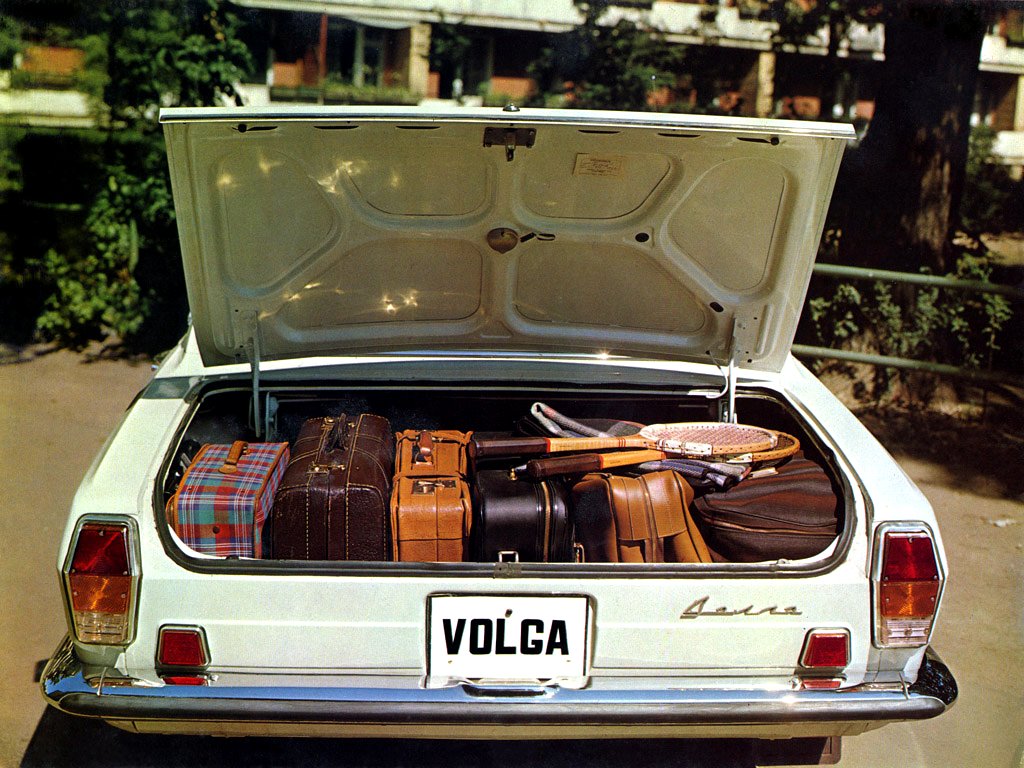
The trunk of the Volga sedan was long and wide, but quite shallow, because it floor was set high to make room for the 55-liter gas tank. The spare tire was mounted horizontally on the trunk floor, taking up a lot of room.
The station wagon offered a lot of extra interior space and featured forward-facing second and third rows of folding seats:
When folded down, they formed a level platform for the cargo:
The trim was very utilitarian as station wagons were for the most part considered to be cargo haulers rather than passenger vehicles, and the back seats were essentially jump seats for occasional trips, designed with little attention to comfort during long road journeys as they were folded down most of the time anyway.
However, the lucky few who could get a Volga wagon for private use usually employed them for vacation trips, and the flat cargo area came in handy as a sleeping surface as well.
In 1986 the updated GAZ-24-10 received a brand new interior, which, while still lowly compared to the “brougham” GAZ-3102 Volga, shared a lot of parts with the latter car, and was for the most part up to the 1980s standards in terms of look, ergonomics and convenience.
Dashboard was now hard molded plastic, with a center console. Instruments and controls were radically improved. The only common part shared with the old style dashboard were the push-pull type switches and knobs.
Upper sections of interior door panels were soft molded plastic, with matching armrests from the Lada parts bin. Lower sections still were vinyl-covered and color-keyed to the interior. Kick plates were now black plastic.
Seats were also completely new, constructed with foam cushions instead of springs. Front seats got contoured side bolsters for better lateral support, adjustable headrests and height adjustment, which made the car more comfortable for taller drivers. Velour upholstery was offered in higher trim levels.

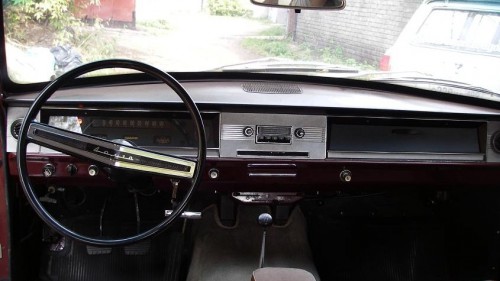
![changes_late_dash[1]](http://gaz24.com/c117592/wp-content/uploads/2013/01/changes_late_dash11-e1392657418177.jpg)


